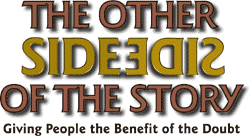Light Lines - Tazria - Metzorah
1 Iyar 5759 / April 17, 1999 Parshat Tazria - Metzorah
Give me one word in English for the French word "chic." Chic is something so quintessentially French that to translate it into English would require a truckload of adjectives.
The characteristics of a nation are evidenced in its language. In every language there are words which cannot be directly translated into any other tongue.
There's a word in Yiddish (and Modern Hebrew) - to fargin. To fargin means to feel pleasure at someone else's success without the slightest twinge of jealousy.
Happiness depends on the way we look at life. We can see our glass as half empty or half full. It all depends on how you use your eyes.
In this week's parsha, there is a lengthy description of a spiritual disease called tzara'as. One of the shortcomings which brought on this affliction was the failure to fargin, a narrowness of the eye, a constriction of the vision.
When a person focuses on reality in the correct fashion, he realizes that there is nothing in this world which is mere coincidence.
For example, let's say my next door neighbor and I both buy lottery tickets. He buys No. 17756233 and I buy No. 17756234. Two weeks later, I wake up and hear him shouting at the top of his voice "I won ten million dollars! I won ten million dollars!"
If my eyes are focused on reality correctly, immediately I should feel tremendous happiness for him, because I had no chance of winning the lottery at all. Even though I had the next ticket, it could have been ticket number 00001 for all the difference it would have made.
Happiness is understanding that what G-d decrees for someone is that person's and always was his. There's no "coming close" to getting what is allotted for someone else. To think otherwise is self-delusion. Realizing this is one of the secrets of happiness in this world.
Interestingly, the words in Hebrew for both the "affliction of tzara'as" and the word for "pleasure" are spelled with exactly the same letters: nun, gimmel, ayin. The affliction of tzara'as is called nega. Pleasure in Hebrew is oneg. The only difference between these two words is where you put the letter ayin.
Ayin in Hebrew means "eye." If you put the ayin in the wrong place, you end up with a spiritual disease - a nega. If you put the ayin in the right place - if you put your eye in the right place - you have pleasure - oneg. The pleasure that comes from farginning -from looking at the world through the lens of reality.
Light Insight | Love of the Land | The Other Side of the Story | Response Line | Ohr Somayach Home Page |
 Selections from classical Torah sources which express the special relationship between the People of Israel and Eretz Yisrael Beit Shemesh This large development town which has become, for many religious Jews, a virtual suburb of Jerusalem was historically tied to the capital of Israel in another way. When the Philistines took the Holy Ark from the Israelites they were so frightened by the havoc which Heaven visited upon them that they sent the Ark back to Israel on a wagon drawn by animals going their way without a human driver. The wagon headed for Beit Shemesh where it was received with great rejoicing. From Beit Shemesh the Ark was eventually carried to Kiryat Yearim, and then to Jerusalem under the direction of King David. |
Light Insight | Love of the Land | The Other Side of the Story | Response Line Ohr Somayach Home Page |
Plant your garden with patience and it will sprout understanding, because...
Every Friday I prepare a list of the jobs that need to be done in preparation for Shabbat and divide them up among my children. The list is then posted on the refrigerator with the child's initials next to each of his or her jobs. It is a pretty good system and works fairly well, but there are always the last minute jobs I forget about. Then my husband or I grab the nearest child and ask him to do that particular task.
Sometimes, though, there are misunderstandings. Last spring, for example, my husband asked my eleven year old to put away the gardening hoe that had been left out. She cheerfully agreed. A half an hour later when he was ready to leave for shul and he saw the hoe still out, he hit the roof. "Didn't you tell me you had put the hoe away!"
My daughter came running to the front door insisting that she had put the hoe away and pointed to the garden hose neatly coiled around the garden faucet. And so we learned in our household, where English is not the first language for all of our children, there are many situations where we need to judge their deeds with the benefit of the doubt.
Light Insight | Love of the Land | Response Line Ohr Somayach Home Page |
Ben Schneider wrote:
Dear Rabbi,Where does the Mishna find its origin? What is the relationship between the Torah, the Talmud, and the Kabala?
Dear Ben,
When G-d gave the Torah to the Jewish people at Mount Sinai, Moses spent 40 days and nights on the mountain with G-d. There G-d gave him the explanation of the written words of the Torah. Moses taught these explanations to the people of Israel who taught their children, and so the understanding of the laws was passed by word of mouth from generation to generation. This is known as the Oral Law.
During the Roman persecutions following the destruction of the second temple, Rabbi Yehuda Hanassi (Judah the Prince 165-192 CE) realized that a long exile was imminent, and that the Oral law was in danger of being lost. He thus took the unprecedented step of writing it down as a book. This book is known as the Mishna, comprising the major teachings of the Tannaim (early scholars from the time of the second temple until about 100 years after the destruction).
The Talmud is the magnum opus containing the explanations and interpretations of the Mishna by the Amoraim (later scholars since the death of Rabbi Yehudah the Nassi) in Babylon, mentioning also the biblical source of the Oral law teachings. It is a composition containing the debates and interpretations discussed in the Babylonian academies between circa 220 CE - 500 CE. It was compiled mainly by Ravinah and Rav Ashi in the last generation of Amoraim so as not to be forgotten when the Jewish people began to live in more and more remote parts of the world. Present day Jewish law is based on the Talmud.
The Kabala is the traditional mystical interpretation of the bible which is also part of the Oral law. This field stresses the reasons and understanding of the commandments and the cause of events stated in the bible. Included in the Kabala is the understanding of the spiritual spheres in the creation and the rules and ways by which G-d administers the existence of the universe.
Produced by the Office of Communications
Editor: Raphael Scott Leban
Production: Eliezer Shapiro
Light Insight: Michael Treblow
HTML Production: Eli Ballon
© 1999 Ohr Somayach International - All rights reserved. This publication may be distributed to another person intact without prior permission. We also encourage you to include this material in other publications, such as synagogue newsletters. However, we ask that you contact us beforehand for permission, and then send us a sample issue.
This publication is available via E-Mail
Ohr Somayach Institutions is an international network of Yeshivot and outreach centers, with branches in North America, Europe, South Africa and South America. The Central Campus in Jerusalem provides a full range of educational services for over 685 full-time students.









